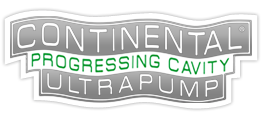
Progressive Cavity Pump Terms
Understanding the pump terminology helps to properly select the best performing Continental Progressive Cavity Pump to fit your pumping needs. Here are a few things you should know:
The Capacity or Volume is the rate of flow in gallons per minute or GPM.
Pressure is determined by how much is required to move the liquid that is being pumped through the piping system and the kind of liquid being handled. The difference between the pressure required at the pump discharge and the pressure being introduced into the pump suction is the differential pressure and is expressed as pounds per square inch or PSI.
Viscosity is the resistance to flow as expressed by various scales of measurement; however, the most commonly used is centipoise. The viscosity usually changes with temperature and should always be considered.
For conversion purposes the formulas below are of value:
Centipoises = centistokes x specific gravity
Centipoises = SSU/5 x specific gravity
SSU= saybolt seconds universal
Temperature refers to the maximum and minimum temperatures at which the fluid is to be pumped. This is a highly important factor in pump selection. High temperatures can cause distortion and swelling of the stator materials and low temperatures can affect viscosity that reflects in flow characteristics and horsepower requirements.
Operating Time or Operating Cycle of the pump should also be considered; whether the pump is to run continuously or intermittently can be a factor in the selection of the drive.
Corrosion depends on whether the fluid being pumped is neutral, acid or alkaline. All should be considered when selecting the proper materials of pump construction. The pH value of the fluid should be known or determined. A pH of 7 is neutral,below 7 is acid and above 7 is alkaline.
Abrasion depends on the abrasive properties of the fluid to be pumped and how they are classified. Abrasives can look alike and appear to have similar properties; however, they can produce different wearing characteristics. You must classify the fluid in order to select the proper pump construction and operating speed. These 4 classifications will serve as a guide and help in the determination of the necessary materials needed in the pump construction:
|
No Abrasives Light Abrasives Medium Abrasives Heavy Abrasives |
Pump failure is a possibility if inaccurate pump application information is given.

